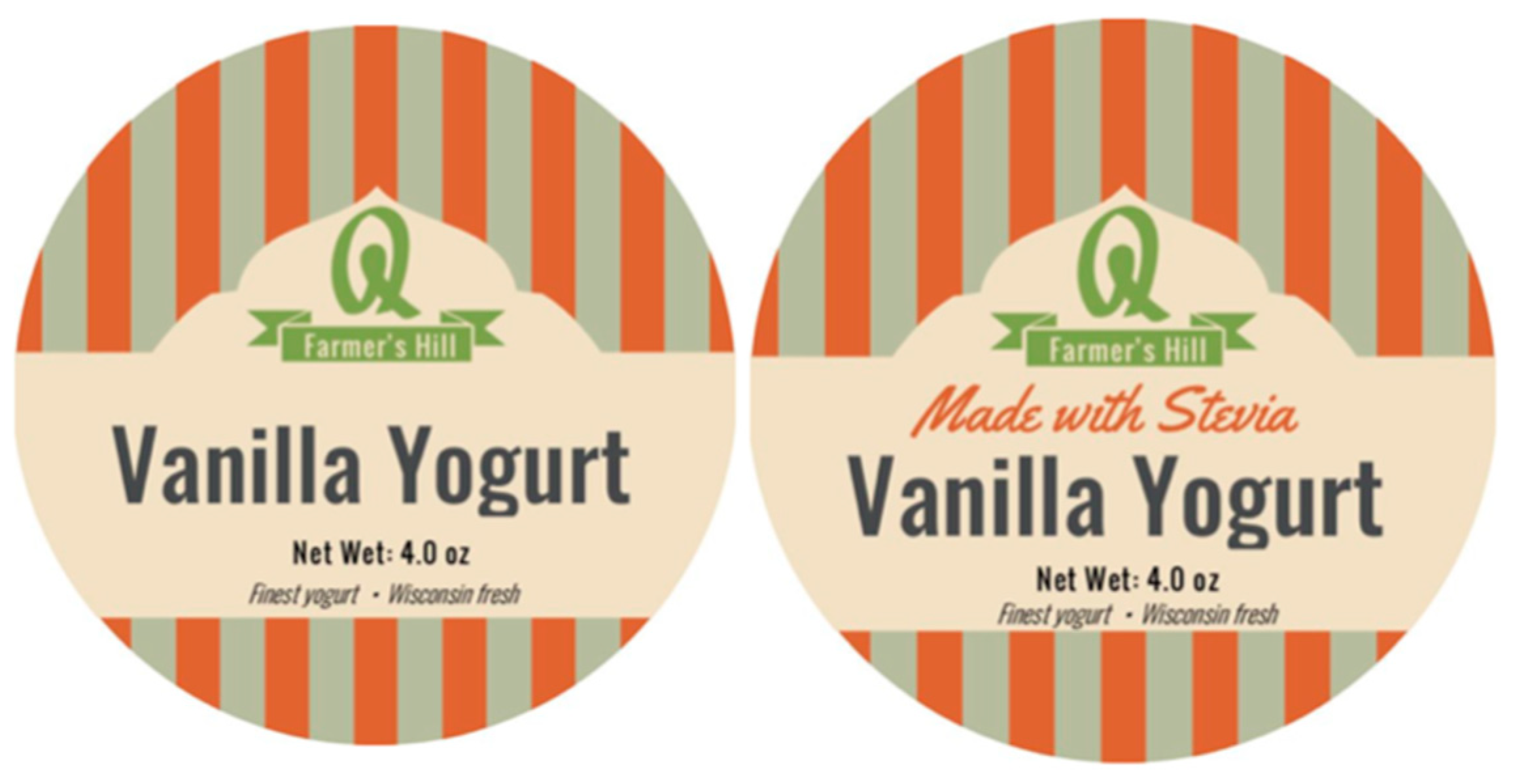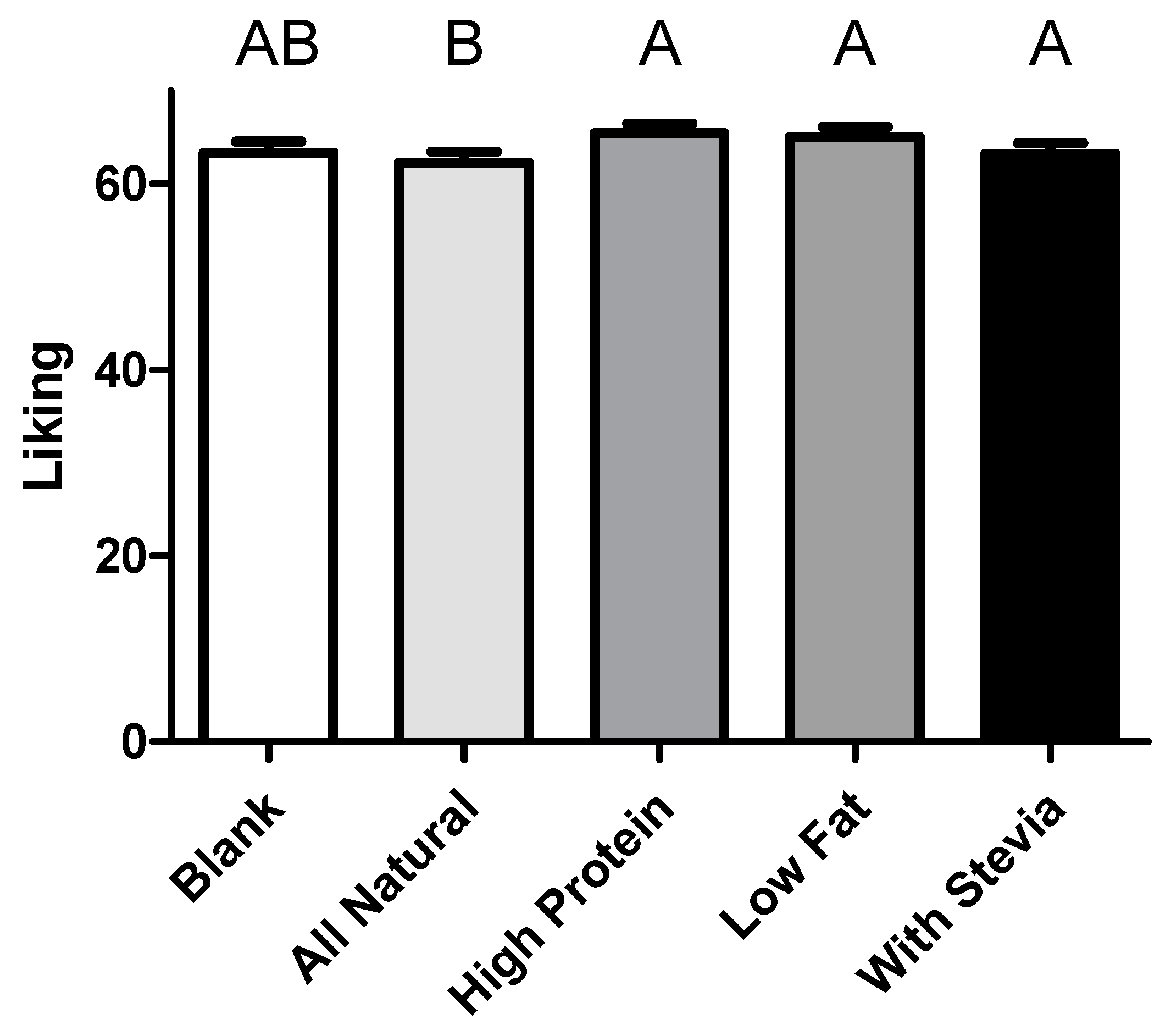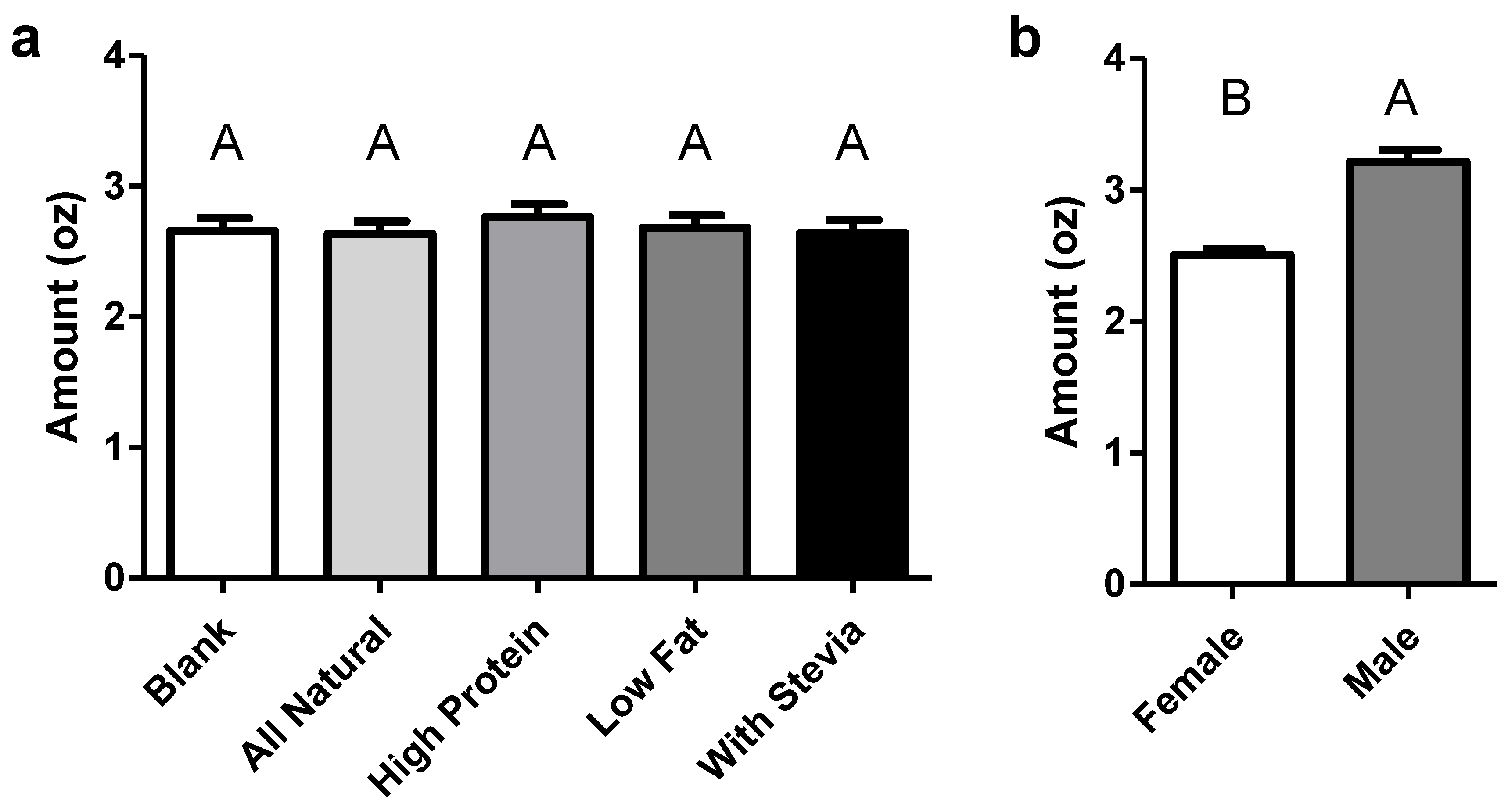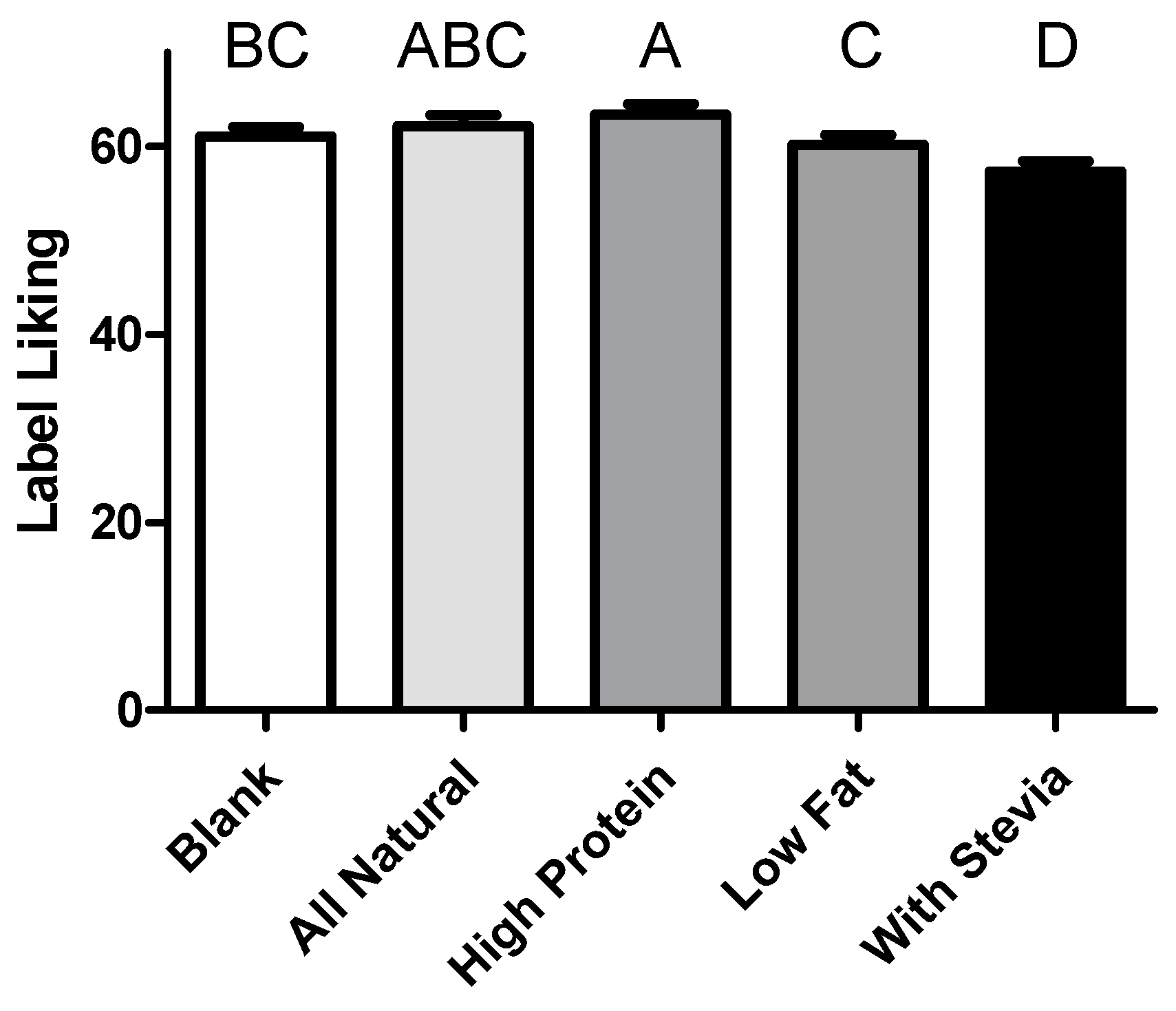Impact of Common Food Labels on Consumer Liking in Vanilla Yogurt
Abstract
1. Introduction
2. Material and Methods
3. Results
4. Discussion
Author Contributions
Funding
Conflicts of Interest
References
- Olson, J.C.; Dover, P.A. Disconfirmation of consumer expectations through product trial. J. Appl. Psychol. 1979, 64, 179–189. [Google Scholar] [CrossRef]
- Okamoto, M.; Dan, I. Extrinsic information influences taste and flavor perception: A review from psychological and neuroimaging perspectives. Semin. Cell Dev. Biol. 2013, 24, 247–255. [Google Scholar] [CrossRef] [PubMed]
- Tuorila, H.; Cardello, A.V.; Lesher, L.L. Antecedents and Consequences of Expectations Related to Fat-free and Regular-fat Foods. Appetite 1994, 23, 247–263. [Google Scholar] [CrossRef] [PubMed]
- Bublitz, M.G.; Peracchio, L.A.; Block, L.G. Why did I eat that? Perspectives on food decision making and dietary restraint. J. Consum. Psychol. 2010, 20, 239–258. [Google Scholar] [CrossRef]
- Piqueras-Fiszman, B.; Spence, C. Sensory expectations based on product-extrinsic food cues: An interdisciplinary review of the empirical evidence and theoretical accounts. Food Qual. Prefer. 2015, 40, 165–179. [Google Scholar] [CrossRef]
- Annett, L.E.; Muralidharan, V.; Boxall, P.C.; Cash, S.B.; Wismer, W.V. Influence of Health and Environmental Information on Hedonic Evaluation of Organic and Conventional Bread. J. Food Sci. 2008, 73, H50–H57. [Google Scholar] [CrossRef] [PubMed]
- Lee, W.J.; Shimizu, M.; Kniffin, K.M.; Wansink, B. You taste what you see: Do organic labels bias taste perceptions? Food Qual. Prefer. 2013, 29, 33–39. [Google Scholar] [CrossRef]
- Thorndike, E.L. A constant error in psychological ratings. J. Appl. Psychol. 1920, 4, 25–29. [Google Scholar] [CrossRef]
- De Pelsmaeker, S.; Schouteten, J.J.; Lagast, S.; Dewettinck, K.; Gellynck, X. Is taste the key driver for consumer preference? A conjoint analysis study. Food Qual. Prefer. 2017, 62, 323–331. [Google Scholar] [CrossRef]
- FDA “‘Natural’ on Food Labeling”, 22 October 2018. Available online: https://www.fda.gov/food/food-labeling-nutrition/use-term-natural-food-labeling (accessed on 11 February 2019).
- Amos, C.; Pentina, I.; Hawkins, T.G.; Davis, N. “Natural” labeling and consumers’ sentimental pastoral notion. J. Prod. Brand Manag. St. Barbar. 2014, 23, 268–281. [Google Scholar] [CrossRef]
- Dominick, S.R.; Fullerton, C.; Widmar, N.J.O.; Wang, H. Consumer Associations with the ‘All Natural’ Food Label. J. Food Prod. Mark. 2018, 24, 249–262. [Google Scholar] [CrossRef]
- Dubé, L.; Fatemi, H.; Lu, J.; Hertzer, C. The Healthier the Tastier? USA–India Comparison Studies on Consumer Perception of a Nutritious Agricultural Product at Different Food Processing Levels. Front. Public Health 2016, 4. [Google Scholar] [CrossRef] [PubMed]
- Liu, R.; Hooker, N.H.; Parasidis, E.; Simons, C.T. A Natural Experiment: Using Immersive Technologies to Study the Impact of ‘All-Natural’ Labeling on Perceived Food Quality, Nutritional Content, and Liking. J. Food Sci. 2017, 82, 825–833. [Google Scholar] [CrossRef] [PubMed]
- Li, M.; Chapman, G.B. Why Do People Like Natural? Instrumental and Ideational Bases for the Naturalness Preference. J. Appl. Soc. Psychol. 2012, 42, 2859–2878. [Google Scholar] [CrossRef]
- Umberger, W.J.; McFadden, D.D.T.; Smith, A.R. Does altruism play a role in determining U.S. consumer preferences and willingness to pay for natural and regionally produced beef? Agribusiness 2009, 25, 268–285. [Google Scholar] [CrossRef]
- Nielsen. “Protein: Consumers Want It, But Don’t Understand It.” 18 September 2018. Available online: http://www.nielsen.com/us/en/insights/news/2018/protein-consumers-want-it-but-dont-understand-it (accessed on 13 February 2019).
- Vandewater, K.; Vickers, Z. Higher-protein foods produce greater sensory-specific satiety. Physiol. Behav. 1996, 59, 579–583. [Google Scholar] [CrossRef]
- Douglas, S.M.; Ortinau, L.C.; Hoertel, H.A.; Leidy, H.J. Low, moderate, or high protein yogurt snacks on appetite control and subsequent eating in healthy women. Appetite 2013, 60, 117–122. [Google Scholar] [CrossRef]
- Shai, I.; Schwarzfuchs, D.; Henkin, Y.; Shahar, D.R.; Witkow, S.; Greenberg, I.; Golan, R.; Fraser, D.; Bolotin, A.; Vardi, H.; et al. Weight Loss with a Low-Carbohydrate, Mediterranean, or Low-Fat Diet. N. Engl. J. Med. 2008, 359, 229–241. [Google Scholar] [CrossRef]
- Fleming, R.M. The effect of high-, moderate-, and low-fat diets on weight loss and cardiovascular disease risk factors. Prev. Cardiol. 2002, 5, 110–118. [Google Scholar] [CrossRef]
- National Heart, Lung, and Blood Institute. Low-Calorie, Lower-Fat Alternative Foods. Available online: https://www.nhlbi.nih.gov/health/educational/lose_wt/eat/shop_lcal_fat.htm (accessed on 13 February 2019).
- Bowen, D.; Green, P.; Vizenor, N.; Vu, C.; Kreuter, P.; Rolls, B. Effects of fat content on fat hedonics: Cognition or taste? Physiol. Behav. 2003, 78, 247–253. [Google Scholar] [CrossRef]
- Norton, J.E.; Fryer, P.J.; Parkinson, J.A. The effect of reduced-fat labelling on chocolate expectations. Food Qual. Prefer. 2013, 28, 101–105. [Google Scholar] [CrossRef]
- Kähkönen, P.; Tuorila, H.; Lawless, H. Lack of effect of taste and nutrition claims on sensory and hedonic responses to a fat-free yogurt. Food Qual. Prefer. 1997, 8, 125–130. [Google Scholar] [CrossRef]
- Mintel. Yogurt and Yogurt Drinks-US-October 2018: Executive Summary. October 2018. Available online: http://academic.mintel.com/display/922642/ (accessed on 3 February 2019).
- Sterk, R. Avoidance of sugar remains macro trend. Food Business News, 28 Feb 2018. Available online: https://www.foodbusinessnews.net/articles/11380-avoidance-of-sugar-remains-macro-trend?v=preview (accessed on 14 February 2019).
- Li, X.E.; Lopetcharat, K.; Drake, M.A. Parents’ and Children’s Acceptance of Skim Chocolate Milks Sweetened by Monk Fruit and Stevia Leaf Extracts. J. Food Sci. 2015, 80, S1083–S1092. [Google Scholar] [CrossRef] [PubMed]
- Lagast, S.; Steur, H.D.; Schouteten, J.J.; Gellynck, X. A comparison of two low-calorie sweeteners and sugar in dark chocolate on sensory attributes and emotional conceptualisations. Int. J. Food Sci. Nutr. 2018, 69, 344–357. [Google Scholar] [CrossRef]
- Vickers, Z.M. Incorporating Tasting into a Conjoint Analysis of Taste, Health Claim, Price and Brand for Purchasing Strawberry Yogurt1. J. Sens. Stud. 1993, 8, 341–352. [Google Scholar] [CrossRef]
- Morelli, L. Yogurt, living cultures, and gut health. Am. J. Clin. Nutr. 2014, 99, 1248S–1250S. [Google Scholar] [CrossRef]
- Clark, S.; Bodyfelt, F.W. (Eds.) The Sensory Evaluation of Dairy Products, 2nd ed.; Springer: New York, NY, USA, 2009. [Google Scholar]
- Fisberg, M.; Machado, R. History of yogurt and current patterns of consumption. Nutr. Rev. 2015, 73, 4–7. [Google Scholar] [CrossRef]
- USDA. Dairy Products: Per Capita Consumption, United States (in Pounds per Person). Available online: https://www.ers.usda.gov/webdocs/DataFiles/48685/pcconsp_1_.xlsx?v=339.1 (accessed on 1 November 2019).
- Luckow, T.; Moskowitz, H.R.; Beckley, J.; Hirsch, J.; Genchi, S. The Four Segments of Yogurt Consumers: Preferences and Mind-Sets. J. Food Prod. Mark. 2005, 11, 1–22. [Google Scholar] [CrossRef]
- Wang, H.; Livingston, K.A.; Fox, C.S.; Meigs, J.B.; Jacques, P.F. Yogurt consumption is associated with better diet quality and metabolic profile in American men and women. Nutr. Res. 2013, 33, 18–26. [Google Scholar] [CrossRef]
- Panahi, S.; Fernandez, M.A.; Marette, A.; Tremblay, A. Yogurt, diet quality and lifestyle factors. Eur. J. Clin. Nutr. 2017, 71, 573–579. [Google Scholar] [CrossRef]
- Noel, C.A.; Sugrue, M.; Dando, R. Participants with pharmacologically impaired taste function seek out more intense, higher calorie stimuli. Appetite 2017, 117, 74–81. [Google Scholar] [CrossRef] [PubMed]
- Schutz, H.G.; Cardello, A.V. A Labeled Affective Magnitude (lam) Scale for Assessing Food Liking/Disliking1. J. Sens. Stud. 2001, 16, 117–159. [Google Scholar] [CrossRef]
- Ebneter, D.S.; Latner, J.D.; Nigg, C.R. Is less always more? The effects of low-fat labeling and caloric information on food intake, calorie estimates, taste preference, and health attributions. Appetite 2013, 68, 92–97. [Google Scholar] [CrossRef] [PubMed]
- Soldavini, J.; Crawford, P.; Ritchie, L.D. Nutrition Claims Influence Health Perceptions and Taste Preferences in Fourth- and Fifth-Grade Children. J. Nutr. Educ. Behav. 2012, 44, 624–627. [Google Scholar] [CrossRef]
- USDA. Appendix 2. Estimated Calorie Needs per Day, by Age, Sex, and Physical Activity Level – 2015–2020 Dietary Guidelines - health.gov. Dietary Guidelines 2015–2020, December 2015. Available online: https://health.gov/dietaryguidelines/2015/guidelines/appendix-2/ (accessed on 1 June 2019).
- Lancashire, E.; Goode, J.; Keil, T.; Beardsworth, A.; Haslam, C.; Bryman, A. Women, men and food: The significance of gender for nutritional attitudes and choices. Br. Food J. 2002, 104, 470–491. [Google Scholar]
- Wardle, J.; Griffith, J. Socioeconomic status and weight control practices in British adults. J. Epidemiol. Community Health 2001, 55, 185–190. [Google Scholar] [CrossRef]
- Wardle, J.; Haase, A.M.; Steptoe, A.; Nillapun, M.; Jonwutiwes, K.; Bellisie, F. Gender differences in food choice: The contribution of health beliefs and dieting. Ann. Behav. Med. 2004, 27, 107–116. [Google Scholar] [CrossRef]
- Velasco, C.; Woods, A.T.; Petit, O.; Cheok, A.D.; Spence, C. Crossmodal correspondences between taste and shape, and their implications for product packaging: A review. Food Qual. Prefer. 2016, 52, 17–26. [Google Scholar] [CrossRef]
- Spence, C.; Levitan, C.A.; Shankar, M.U.; Zampini, M. Does Food Color Influence Taste and Flavor Perception in Humans? Chem. Percept. 2010, 3, 68–84. [Google Scholar] [CrossRef]
- Sugrue, M.; Dando, R. Cross-modal influence of colour from product and packaging alters perceived flavour of cider. J. Inst. Brew. 2018, 124, 254–260. [Google Scholar] [CrossRef]
- Velasco, C.; Woods, A.T.; Hyndman, S.; Spence, C. The Taste of Typeface. i-Perception 2015, 6. [Google Scholar] [CrossRef] [PubMed]
- Mojet, J.; Christ-Hazelhof, E.; Heidema, J. Taste Perception with Age: Generic or Specific Losses in Threshold Sensitivity to the Five Basic Tastes? Chem. Senses 2001, 26, 845–860. [Google Scholar] [CrossRef] [PubMed]
- Zandstra, E.H.; de Graaf, C. Sensory perception and pleasantness of orange beverages from childhood to old age. Food Qual. Prefer. 1998, 9, 5–12. [Google Scholar] [CrossRef]
- Kapaun, C.L.; Dando, R. Deconvoluting physical and chemical heat: Temperature and spiciness influence flavor differently. Physiol. Behav. 2017, 170, 54–61. [Google Scholar] [CrossRef]
- Noel, C.A.; Cassano, P.A.; Dando, R. College-Aged Males Experience Attenuated Sweet and Salty Taste with Modest Weight Gain. J. Nutr. 2017, 147, 1885–1891. [Google Scholar] [CrossRef]
- Leidy, H.J.; Ortinau, L.C.; Douglas, S.M.; Hoertel, H.A. Beneficial effects of a higher-protein breakfast on the appetitive, hormonal, and neural signals controlling energy intake regulation in overweight/obese, ‘breakfast-skipping,’ late-adolescent girls. Am. J. Clin. Nutr. 2013, 97, 677–688. [Google Scholar] [CrossRef]
- McFadden, J.R.; Huffman, W.E. Willingness-to-pay for natural, organic, and conventional foods: The effects of information and meaningful labels. Food Policy 2017, 68, 214–232. [Google Scholar] [CrossRef]
- Van Loo, E.J.; Caputo, V.; Nayga, R.M.; Meullenet, J.-F.; Ricke, S.C. Consumers’ willingness to pay for organic chicken breast: Evidence from choice experiment. Food Qual. Prefer. 2011, 22, 603–613. [Google Scholar] [CrossRef]
- Vecchio, R.; Loo, E.J.V.; Annunziata, A. Consumers’ willingness to pay for conventional, organic and functional yogurt: Evidence from experimental auctions. Int. J. Consum. Stud. 2016, 40, 368–378. [Google Scholar] [CrossRef]
- Hemmerling, S.; Spiller, A.; Canavari, M. Preference for naturalness of European organic consumers: First evidence of an attitude-liking gap. Br. Food J. 2016, 118, 2287–2307. [Google Scholar] [CrossRef]
- Kamarulzaman, N.H.; Jamal, K.; Vijayan, G.; Jalil, S.M.A. Will Consumers Purchase Stevia as a Sugar Substitute? An Exploratory Study on Consumer Acceptance. J. Food Prod. Mark. 2014, 20, 122–139. [Google Scholar] [CrossRef]
- Zugravu, C.A.; Pogurschi, E.N.; Patrascu, D.; Iacob, P.-D.; Nicolae, C.G. Attitudes Towards Food Additives: A Pilot Study. Ann. Univ. Dunarea de Jos Galati Fascicle VI. Food Technol. Galati 2017, 41, 50–61. [Google Scholar]




© 2019 by the authors. Licensee MDPI, Basel, Switzerland. This article is an open access article distributed under the terms and conditions of the Creative Commons Attribution (CC BY) license (http://creativecommons.org/licenses/by/4.0/).
Share and Cite
Li, T.; Dando, R. Impact of Common Food Labels on Consumer Liking in Vanilla Yogurt. Foods 2019, 8, 584. https://doi.org/10.3390/foods8110584
Li T, Dando R. Impact of Common Food Labels on Consumer Liking in Vanilla Yogurt. Foods. 2019; 8(11):584. https://doi.org/10.3390/foods8110584
Chicago/Turabian StyleLi, Theresa, and Robin Dando. 2019. "Impact of Common Food Labels on Consumer Liking in Vanilla Yogurt" Foods 8, no. 11: 584. https://doi.org/10.3390/foods8110584
APA StyleLi, T., & Dando, R. (2019). Impact of Common Food Labels on Consumer Liking in Vanilla Yogurt. Foods, 8(11), 584. https://doi.org/10.3390/foods8110584




